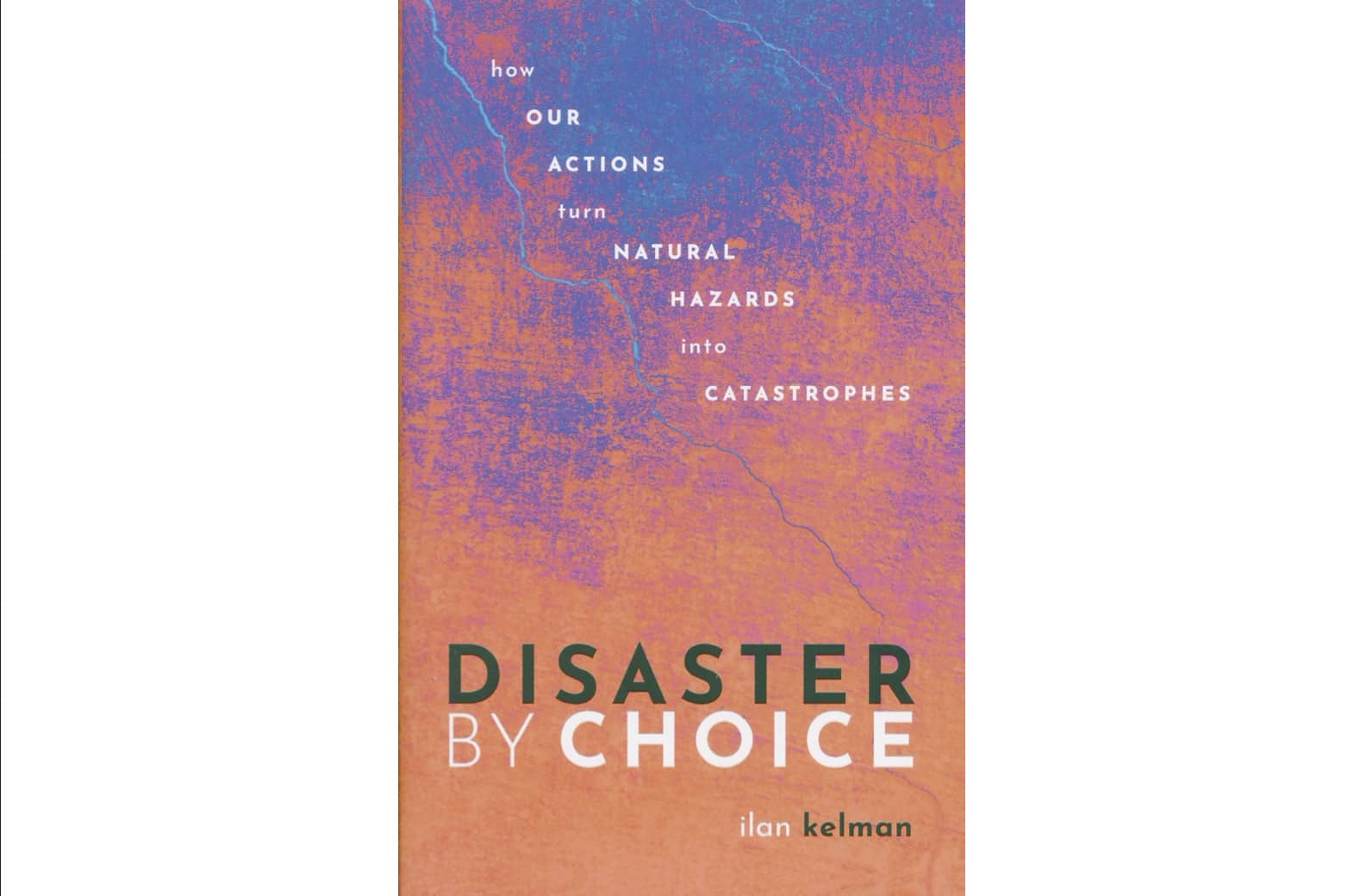
www.buildingsandcities.org/insights/reviews/disaster-choice-how-our-actions-turn.html
Disaster by Choice: How our Actions turn Natural Hazards into Catastrophes

By Ilan Kelman. Oxford University Press, 2020, ISBN: 9780198841340
James Lewis (Datum International) reviews this book which
provides significant insights into what really causes disasters and how to avoid them in
policy, strategy and practice. Natural disasters are not "natural", they are hazards that are amplified into disasters as a consequence of human actions. Making more intelligent choices about these hazards will reduce our vulnerability.
The arrival of this perfectly crafted and well written book is ideally timed. The dramatic current onset of climate-related disasters, wildfires, storms and floods around the world, the sudden emergence of the climate emergency movement, and the COVID-19 pandemic provide a fitting context. As the author so profusely describes, our vulnerability to these present hazards was created years ago. This book is long overdue, much needed and greatly welcomed.
In this passionately informed demonstration of realities, Kelman makes a distinction between the hazard, which is natural, and the disaster which is not. It very thoroughly explains that 'natural disasters' are not natural at all. These events are caused by shortcomings of humankind. A disaster lies not in the forces unleashed by nature, but in its impacts on human society. These include deaths and injuries, the loss of irreplaceable homes and livelihoods, and the failure to support affected people, so that a short-term interruption becomes a long-term recovery nightmare.
Neither the tornado, the earthquake nor the tsunami are to blame. They are each manifestations of nature which have occurred countless times over the aeons of Earth's history. The disaster consists of a societal inability to deal with hazards as part of the natural contexts in which we live. We have the knowledge, ability, technology, and resources to build houses which are not ripped apart by high winds. Or we could choose to create a culture with warning and safe sheltering. Or we could avoid places likely to be hit. Or we could accept periodic destruction (with warning systems and safe evacuation) to permit rebuilding afterwards. The key message is that options exist for choosing where we live, how we build, and how we prepare ourselves for living with nature. Many of the current choices permit death and devastation. Collectively and individually, we create the conditions for disasters. Nature does not choose, but we do. It is our choice to avoid disasters - which means disasters are not natural.
Straightforward and brilliantly described accounts are provided of how disasters are caused by vulnerabilities to natural hazards. This book should be compulsory reading by those whose actions and inactions create vulnerabilities: leaders of national, state and local governments, heads and members of all authorities related to environment, agriculture, forestry, water courses, shorelines and for power supplies, public health, finance, education, construction, architecture and civil engineering - and those in educational institutions associated with all of these. Its reading will introduce each discipline and activity to its specific responsibilities. The book also provides a multidisciplinary perspective. It offers insights and alternatives to the narrow thinking resulting from departmentalism.
Not all human disasters are sudden events or noted in the news. Many occur with regularity due to a lack of human agency and planning. The fact that these have become routine does not mean they are acceptable. For example, normal, seasonal weather regularly kills thousands annually from hot and humid or cold and windy weather. If all of us could afford adequate indoor temperature control, then we could make a choice about heating and cooling our rooms. Why do large segments of the populations have trouble providing themselves with such a basic necessity? Vulnerability by economics is more an issue of family finances. It raises social questions about our response to natural hazards: why energy costs are not affordable for everyone; why residential buildings are not designed or retrofitted for weather variations and why those in rented accommodation are typically more fuel impoverished than owner occupiers. Not all vulnerability by economics is a one-way street. Even where poverty leads to vulnerability, the converse of vulnerability leading to poverty also emerges. Without addressing vulnerability over the longer term, poverty will be both a cause and a consequence of disasters that repeatedly recur.
Ultimately, vulnerability is due to political decisions. To address this problem, Kelman suggests new processes are needed to identify and confront people, organisations and procedures that lead to harmful decisions. Other reasons why vulnerabilities are not overcome relate to excessive ideologies, governance, prejudices, assumptions, power relations, and obstructed access to alternative choices. In most circumstances, certain groups within society make choices for other groups, making or breaking the others' vulnerability. Delving into the nature and causes of vulnerability makes it clear that people are not inherently vulnerable to hazards, but are made vulnerable by society.
When so much current research and political attention is being focused upon people's resilience, this in-depth examination of vulnerability and its causes reveals why, in disaster aftermath, people may have low capacity and capability. The notion of resilience depends upon the assumed capacities and capabilities of people which perhaps explains why governments and authorities make it their preferred option. However, this often fails to counter the causes that can reduce those capacities and capabilities. This book restores the underlying reasons and causes of why people are as they are; it rejects how they are as its starting point.
Disasters reveal the fundamental realities of society and expose the world as it is. Disasters may also provide opportunity for change but often at great human suffering. The beauty of Kelman's book is it also provide an opportunity to change. The book's observations and recommendations require changes in comprehension, systems of governance and reallocations of responsibility and of power. This book is a timely study of urgent worldwide situations of climate change, environmental management and pandemic requiring serious application. It will also help move us toward evidence-based policy. The sooner it is widely read and acted upon, the better the world will be for everyone.Latest Peer-Reviewed Journal Content
Acceptability of sufficiency consumption policies by Finnish households
E Nuorivaara & S Ahvenharju
Key factors for revitalising heritage buildings through adaptive reuse
É Savoie, J P Sapinski & A-M Laroche
Cooler streets for a cycleable city: assessing policy alignment
C Tang & J Bush
Understanding the embodied carbon credentials of modern methods of construction
R O'Hegarty, A McCarthy, J O'Hagan, T Thanapornpakornsin, S Raffoul & O Kinnane
The changing typology of urban apartment buildings in Aurinkolahti
S Meriläinen & A Tervo
Embodied climate impacts in urban development: a neighbourhood case study
S Sjökvist, N Francart, M Balouktsi & H Birgisdottir
Environmental effects of urban wind energy harvesting: a review
I Tsionas, M laguno-Munitxa & A Stephan
Office environment and employee differences by company health management certification
S Arata, M Sugiuchi, T Ikaga, Y Shiraishi, T Hayashi, S Ando & S Kawakubo
Spatiotemporal evaluation of embodied carbon in urban residential development
I Talvitie, A Amiri & S Junnila
Energy sufficiency in buildings and cities: current research, future directions [editorial]
M Sahakian, T Fawcett & S Darby
Sufficiency, consumption patterns and limits: a survey of French households
J Bouillet & C Grandclément
Health inequalities and indoor environments: research challenges and priorities [editorial]
M Ucci & A Mavrogianni
Operationalising energy sufficiency for low-carbon built environments in urbanising India
A B Lall & G Sethi
Promoting practices of sufficiency: reprogramming resource-intensive material arrangements
T H Christensen, L K Aagaard, A K Juvik, C Samson & K Gram-Hanssen
Culture change in the UK construction industry: an anthropological perspective
I Tellam
Are people willing to share living space? Household preferences in Finland
E Ruokamo, E Kylkilahti, M Lettenmeier & A Toppinen
Towards urban LCA: examining densification alternatives for a residential neighbourhood
M Moisio, E Salmio, T Kaasalainen, S Huuhka, A Räsänen, J Lahdensivu, M Leppänen & P Kuula
A population-level framework to estimate unequal exposure to indoor heat and air pollution
R Cole, C H Simpson, L Ferguson, P Symonds, J Taylor, C Heaviside, P Murage, H L Macintyre, S Hajat, A Mavrogianni & M Davies
Finnish glazed balconies: residents' experience, wellbeing and use
L Jegard, R Castaño-Rosa, S Kilpeläinen & S Pelsmakers
Modelling Nigerian residential dwellings: bottom-up approach and scenario analysis
C C Nwagwu, S Akin & E G Hertwich
Mapping municipal land policies: applications of flexible zoning for densification
V Götze, J-D Gerber & M Jehling
Energy sufficiency and recognition justice: a study of household consumption
A Guilbert
Linking housing, socio-demographic, environmental and mental health data at scale
P Symonds, C H Simpson, G Petrou, L Ferguson, A Mavrogianni & M Davies
Measuring health inequities due to housing characteristics
K Govertsen & M Kane
Provide or prevent? Exploring sufficiency imaginaries within Danish systems of provision
L K Aagaard & T H Christensen
Imagining sufficiency through collective changes as satisfiers
O Moynat & M Sahakian
US urban land-use reform: a strategy for energy sufficiency
Z M Subin, J Lombardi, R Muralidharan, J Korn, J Malik, T Pullen, M Wei & T Hong
Mapping supply chains for energy retrofit
F Wade & Y Han
Operationalising building-related energy sufficiency measures in SMEs
I Fouiteh, J D Cabrera Santelices, A Susini & M K Patel
Promoting neighbourhood sharing: infrastructures of convenience and community
A Huber, H Heinrichs & M Jaeger-Erben
New insights into thermal comfort sufficiency in dwellings
G van Moeseke, D de Grave, A Anciaux, J Sobczak & G Wallenborn
'Rightsize': a housing design game for spatial and energy sufficiency
P Graham, P Nourian, E Warwick & M Gath-Morad
Implementing housing policies for a sufficient lifestyle
M Bagheri, L Roth, L Siebke, C Rohde & H-J Linke
The jobs of climate adaptation
T Denham, L Rickards & O Ajulo
Structural barriers to sufficiency: the contribution of research on elites
M Koch, K Emilsson, J Lee & H Johansson
Disrupting the imaginaries of urban action to deliver just adaptation [editorial]
V Castán-Broto, M Olazabal & G Ziervogel
Nature for resilience reconfigured: global- to-local translation of frames in Africa
K Rochell, H Bulkeley & H Runhaar
How hegemonic discourses of sustainability influence urban climate action
V Castán Broto, L Westman & P Huang
Fabric first: is it still the right approach?
N Eyre, T Fawcett, M Topouzi, G Killip, T Oreszczyn, K Jenkinson & J Rosenow
Social value of the built environment [editorial]
F Samuel & K Watson
Understanding demolition [editorial]
S Huuhka
Data politics in the built environment [editorial]
A Karvonen & T Hargreaves



Latest Commentaries
Decolonising Cities: The Role of Street Naming
During colonialisation, street names were drawn from historical and societal contexts of the colonisers. Street nomenclature deployed by colonial administrators has a role in legitimising historical narratives and decentring local languages, cultures and heritage. Buyana Kareem examines street renaming as an important element of decolonisation.
Integrating Nature into Cities
Increasing vegetation and green and blue spaces in cities can support both climate change mitigation and adaptation goals, while also enhancing biodiversity and ecological health. Maibritt Pedersen Zari (Auckland University of Technology) explains why nature-based solutions (NbS) must be a vital part of urban planning and design.